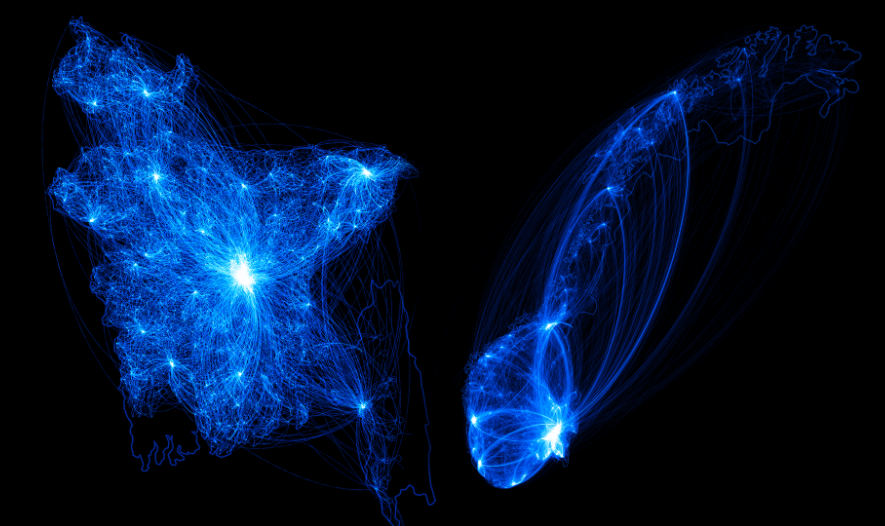5G Networks of things to come

5G Proposed Norwegian network from 2020
The City of the Future
The remote monitoring, real-time diagnostics and preventive maintenance that are becoming part of the U.S. electrical grid will, naturally, bolster those services that rely on it. This is particularly true for the rail transport industry, where the hundreds of data points per second that can be read off of high-speed rolling stock will be leveraged to increase availability and reduce operational costs.
Visibility into real-time operations goes beyond using GPS to glean information about the location and health of rolling stock. By predicting component failures of everything from gearboxes to train doors, operators will be able to fix faulty parts before they ever break down, improving vehicle availability and, as a result, the operational planning of stations and overall energy consumption.

The buildings that rely on the grid for power are also becoming more energy efficient, and advances enabled by the IoT are making old definitions of a “smart” building — like offices that know to lower the heat when people leave for the day — seem quaint.
“It goes beyond HVAC to the security, the fire, the lighting, even elevator and shade control systems,” says Dave Hopping, president and CEO of Siemens’ North American based Building Technologies Division, who points to the ubiquity of sensors as the driver.
“They allow the intelligent building management system [IBMS]to connect more data on a cloud-based platform like MindSphere. The next step is to run analytics on that data to create new applications and operating models for the customer.”
On the security front, this could mean always knowing who is on-premises via a reader. From an efficiency standpoint, conference rooms and offices can be heated or cooled based on their specific usage for the day, while blinds will automatically adjust based on the position of the sun.

Efficient energy use and the dollar savings it brings are crucial selling points, but Hopping sees MindSphere as just as helpful when it comes to predictive maintenance“
You can use analytics to know how a piece of equipment is running, and know it’s going to fail or break before it happens,” he explains. For example, by reading vibrations and temperatures of a fan, the building will sense that lubricant is being lost and a bearing is wearing out. “We’re hoping that the analytics can get so good that they can tell you, ‘This piece is going to fail in this 12-hour window 20 days from now,’” Hopping adds. “If you have that, nothing is an emergency.”
In a not-too-distant future with augmented reality and artificial intelligence, a building technician won’t even have to be inside of it to make a fix: she can be remotely located, with the customer interfacing with the broken equipment via a VR headset. Such a scenario explains the appeal of smart building applications to customers that own real estate across a wide geographic territory. “You don’t have to be in every single building to operate, maintain and interface with it,” says Hopping. “Instead, you can connect your buildings through a cloud-based application. You cannot do that without the Internet of Things.”

At Siemens, this extends to the design portion of the building life-cycle. Using building information modelling (BIM), a digital twin of a structure is designed first, virtually. This allows all stakeholders to weigh in during planning, preventing costly and time-intensive modifications on the construction site, resulting in a 10 percent budget savings due to error detection, a 7 percent shorter project timeline and up to 3.5 percent more efficient occupancy (since modeled buildings often have a smaller footprint).
It may seem like the stuff of science fiction, but Hopping is optimistic that building
analytics in a cloud environment can make it a reality. Perhaps someday soon, the
next concert hall or college campus — or even an entire city skyline — will truly be a smart one.
MindSphere
SEVASTOPOL-USA WARNING

Public Health Crisis: Deaths and Illnesses at Petaluma Ave. and Walker Ave. Homes. Crown Castle Macro Cell Tower is 250 to 500 Feet From These Homes and Just 75 Feet from the Sonoma West Medical Center
Deaths . . .
Deceased 1 — lived about 260 ft. from the Cell Tower, from 2009 until her death in 2010 She was in her mid-forties and moved into PAH shortly after receiving a diagnosis of breast cancer. During the one year she lived here, she grew progressively worse until she needed special care and had to leave. She died shortly afterwards off-site.
Deceased 2 — lived about 260 ft. from the Cell Tower, from 2009 until his death in 2011. He was in his 60’s and had heart issues. He was found unconscious in his apartment. He died shortly afterwards off-site.
Deceased 3 — lived about 275 ft. from the Cell Tower, from 2009 until her death in 2015. She was in her 60’s when she moved in. She had osteoporosis that progressed to such a point she experienced continual excruciating pain and loss of full mobility. She died in her apartment.
Deceased 4 — lived about 275 ft. from the Cell Tower, from 2009 until his death in 2013. He was in his 60’s and had diabetes which progressed to the point where he became wheel chair bound. Eventually he had one leg then the other leg amputated. He died in the apartment.
Deceased 5 — lived about 350 ft. from the Cell Tower, from 2009 until her death in 2013. She was in her 20’s when she moved here and was healthy. She was diagnosed with breast cancer shortly after the birth of her child around 2011. She died at age 33 and left a 2 ½ year old son. She died in her apartment.
FCC Chair Ajit Pai Denies 5G Health Risks to Congress
https://www.youtube.com/embed/rk6Oy-Mw0bk
Utility of Assesing Human Health Risk from National Toxicology Cell Phone Radiation Study